User Manual
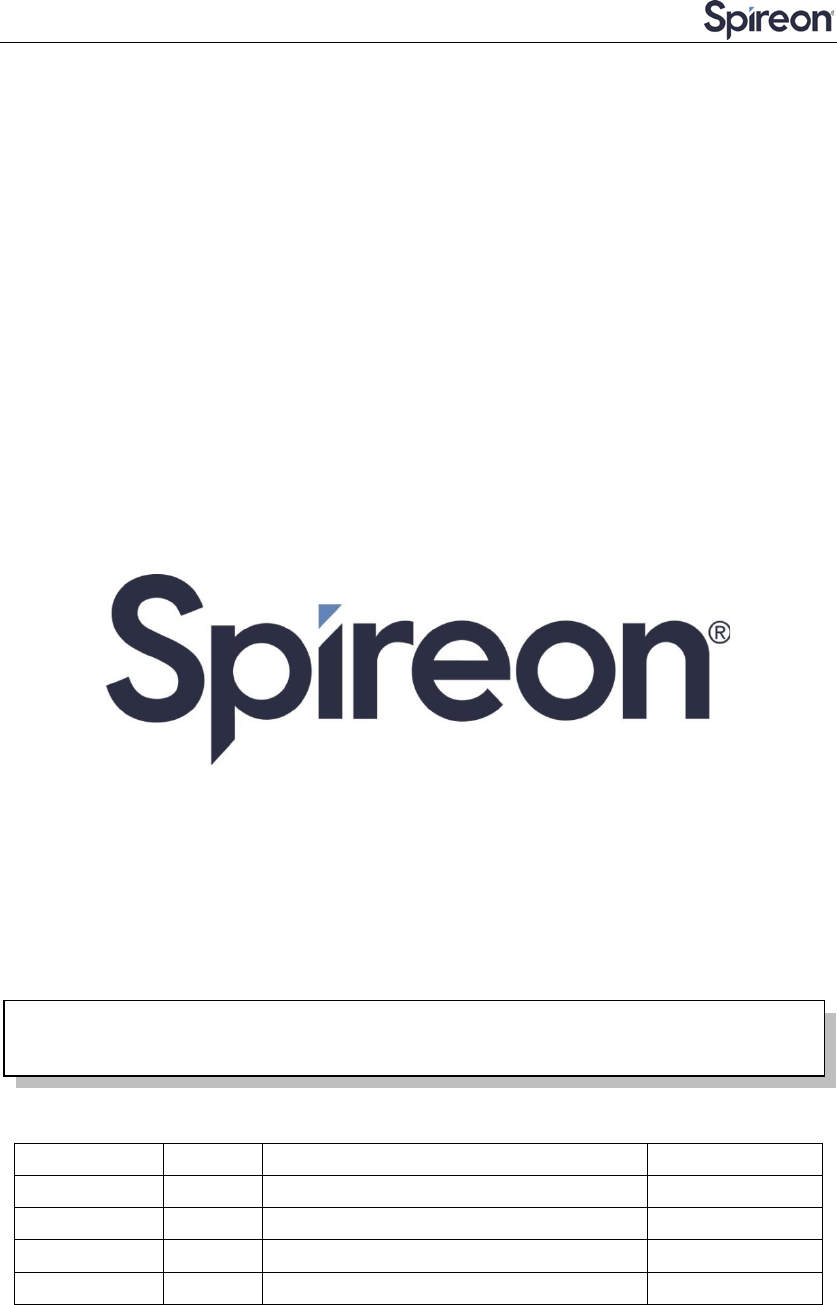
© 2017 Spireon, Inc.1 / 22
User Manual
For the
JG-H
Trailer Tracking Device
July10, 2017
R1.2
Author Revision Changes Date
Hao 1.1 Initial version 2017-07-10
Ewing 1.2 Edits 2017-07-20
The information presented in this document is strictly confidential and contains trade secrets
and other confidential information that are the exclusive property of Spireon Inc.

© 2017 Spireon, Inc.2 / 22

© 2017 Spireon, Inc.3 / 22
Contents
1 Introduction ............................................................................................................................... 4
2 Hardware Design....................................................................................................................... 5
2.1 Basic Hardware ................................................................................................................ 5
2.2 Basic RF Performance ...................................................................................................... 7
2.3 Certification and Safety .................................................................................................. 10
3 Software Features .................................................................................................................... 11
3.1 Basic Software ................................................................................................................ 11
3.2 Remote Update ............................................................................................................... 11
3.3 Power Modes .................................................................................................................. 11
3.4 AT Command ................................................................................................................. 12
3.5 Reset ............................................................................................................................... 18
3.5.1 Context Preservation .................................................................................................. 18
3.6 Startup Banner ................................................................................................................ 18
3.7 Hardware ........................................................................................................................ 19
3.8 Software Test .................................................................................................................. 19
Mechanical Structure(mm) ............................................................................................................. 20
FCC Statement ................................................................................................................................ 21
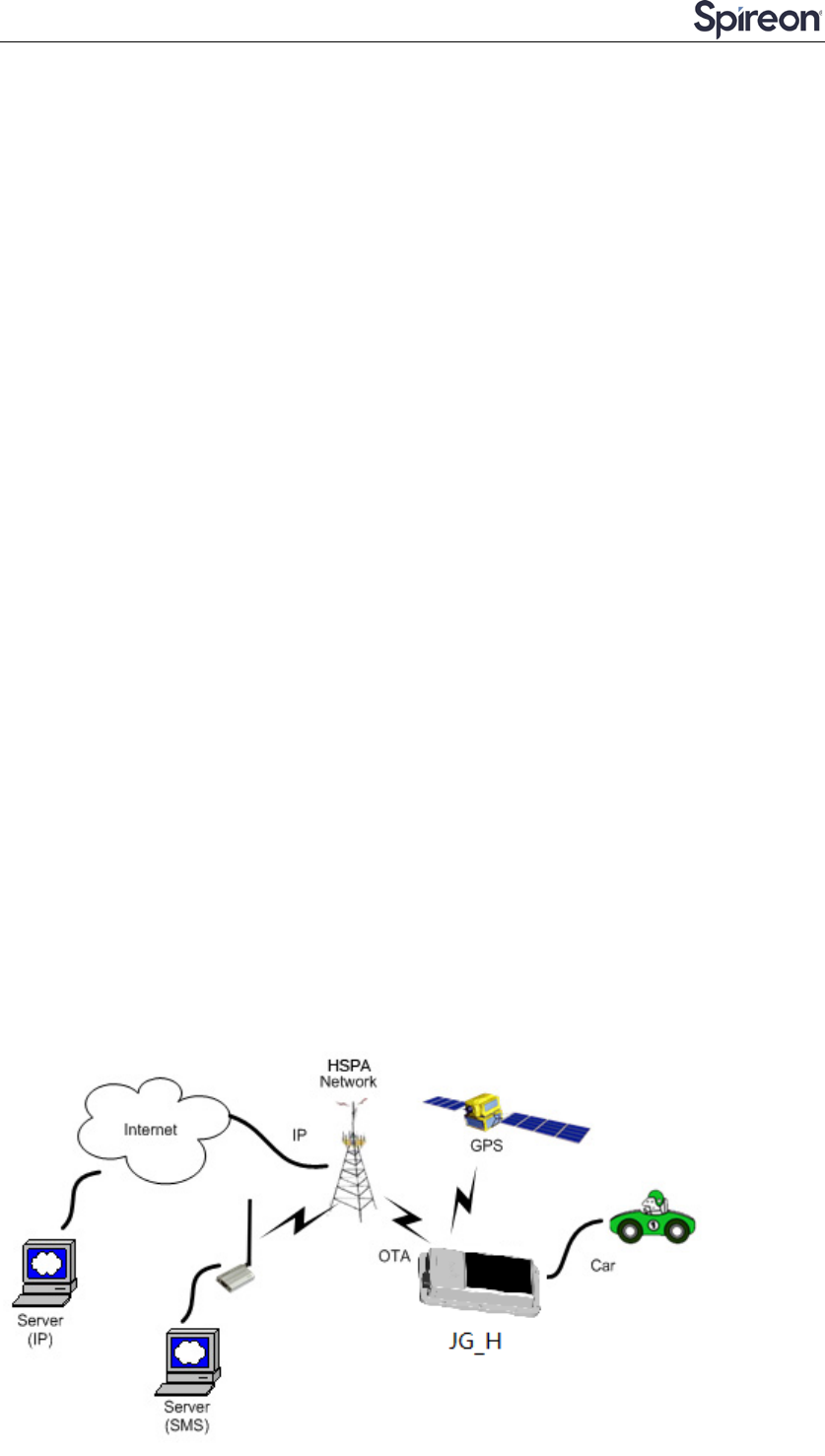
© 2017 Spireon, Inc.4 / 22
1 Introduction
TheJG-His a self-contained trailer tracking device that combines GPS location with
WCDMA/GSM/GPRSconnectivity.It is primarily a location reporting device that responds to
requests (user, server) and events (timers, geo-fences). Data reports consist of a single record
that contains all location data and system status.
The device comes pre-configured from the factory, ready to use.TheJG-H appears to a user or
a server application as a single endpoint device. It can be queried, updated and configured
either through a serial connection, an over the air IP connection, or through SMS messaging.
TheJG-Hpresents itself over these connections as an enhanced cellular modem with attached
functional elements. These elements include:
• GPS
• Accelerometer
• I/O pins and tamper alert
• Serial UART port for management and for cargo sensor
• Status LEDs
• Timers
• Watchdog lockup protection
• Power Management
• Power Output
• Solar panel power supply
Access to these elements and general purpose interfaces is done through an extended AT
command set as defined herein.Configuration parameters are stored to flash memory and
are automatically used on the next power up event. For more details, please reference the
AT Command document.
Diagram

© 2017 Spireon, Inc.5 / 22
This product is designed based on the MT6276 Baseband chipset, supporting WCDMAand
GPRS protocol for wirelessdata; using an internal dual band antenna(GSM850&PCS 1900).
The device also includes stand-alone GPS functionality, an accelerometer for motion
detection, as well as support for solar panel power supply. The JG-H can operate from an
internal rechargeable battery or an external power source. The battery is recharging via the
solar panel or external power.
2 Hardware Design
2.1 Basic Hardware
Items
Requirement
Baseband Chipset
MT6276A
RF 2G Transceiver
RF3235
RF 3G Transceiver RF7411TR7
Memory
MCP_NAND 1Gb(x16) / mobile DDR
512Mb(x16)
Cellular Network
Supportfor WCDMA Class 12 GPRS, GPS
Frequency
2G band support : 850MHz & 1.8GHz
Support for 12 class GPRS
3G band support : Band2 and Band5
Antenna Internal Antenna[850M&1900M]
GPS Antenna Dedicate high performance ceramic antenna
UIM requirement
No-UIM mode, SIM card connector
Interface
Main PWR – 12V DC
(
1.5A current
)
Aux PWR – 12V DC
(
1.5A current
)
Solar PWR (battery charge)
GND
PWR OUT (3.3V, 300mA current)
UART TX
UART RX
Relay Drive Output (12V, 500mA current)
1-Wire
GPIO1
Tamper
Power Monitor
internal analog input scaled – battery, external
power, solar
Build in battery manager Supported
Dedicate Timers
Yes
Watchdog
Supported
Motion Detect
Accelerometer
LED
3 status LEDs (Green, Red, and Orange)
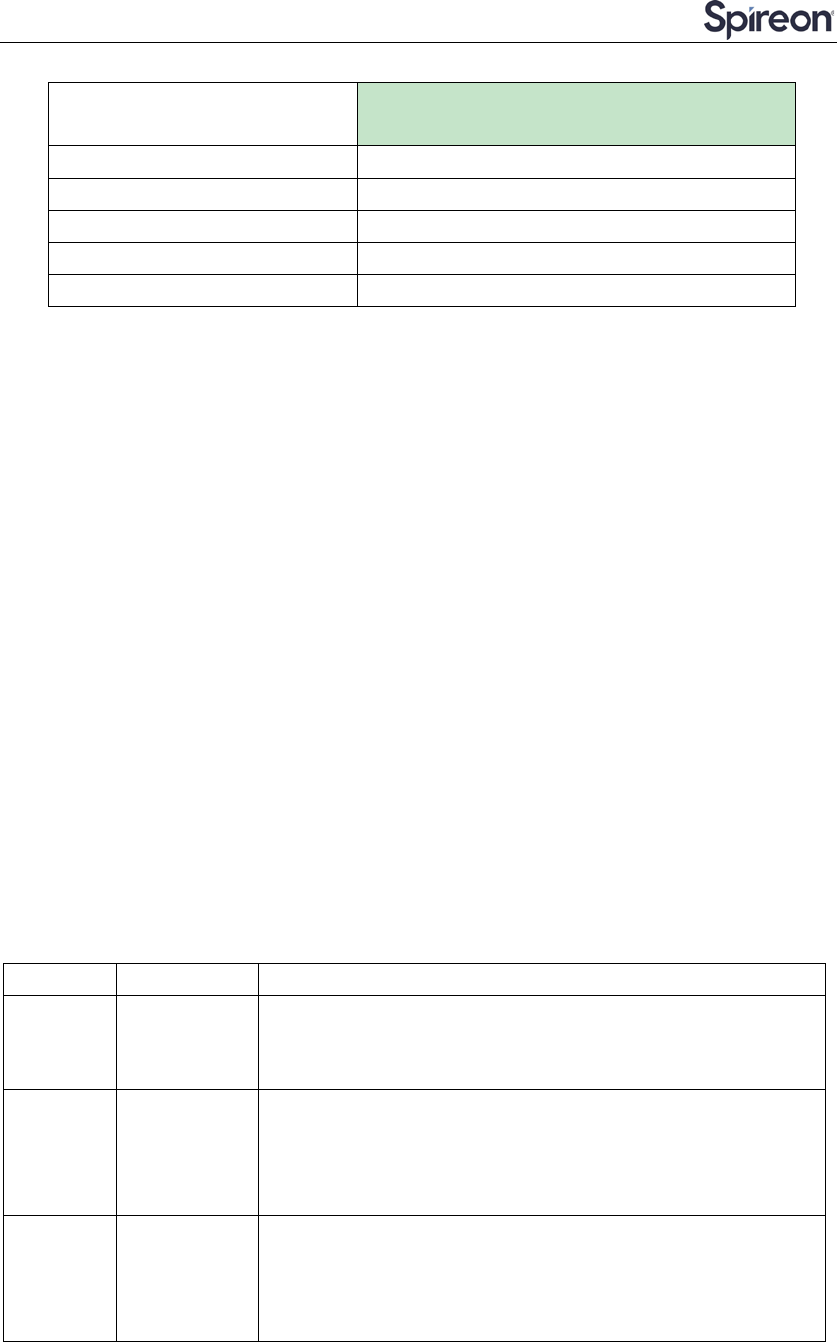
© 2017 Spireon, Inc.6 / 22
Battery Built in rechargeable batteryfor up to 6 months
of typical operation
Power Switch
No
Power Cable connector type
23 - pin
Power Out Yes
Solar Panel Yes
Power Consumption <20 Watts
The JG-Hprovides support for specialized hardware features through extended AT commands.
The features supported include the following.
GPS
GPS location functionality is provided by the device GPS receiver. Warm start from sleep is
supported.
GPIO
One general purpose GPIO and three additional multiplexed IO’s are presented to the external
environment on the main connector. They are capable of providing system interrupts to
generate a report or drive logic levels to external devices. These lines are 2.8V logic level and
are 16V tolerant. The multiplexed IO’s are typically configured as Ignition, Relay and
Tamper.
LED’s
Three LED status indicators are provided to verify correct installation and operation. The
status LEDs are color coded and directly convey the status of the cellular and GPS
subsystems, as well as the power input; described in the table below. Their valid operation
also indicates operational status and power.
LED Function Status
Red GPS On: GPS satellites acquired and locked
Flash Slow: GPS satellite search is in progress
Off: GPS is turned off
Green
Cellular
Connection
On:
Indicates cellulardata connection is available
Flash Slow: cellular subsystem initialized but no connection
Flash Fast: cellular initialization in process
Off: Cellular sub-system is off
Orange
Battery
charging
On: Indicates external power and battery is fully charged
Flash: Indicates external power and battery is charging
Off
: Indicates running from battery. Blinks shortly every
30sec.
The JG-H provides user control allowing the LEDs to be extinguished once installation is
verified. This feature reduces power and further conceals the JG-H Tracker from untrained
parties wishing to defeat its operation.
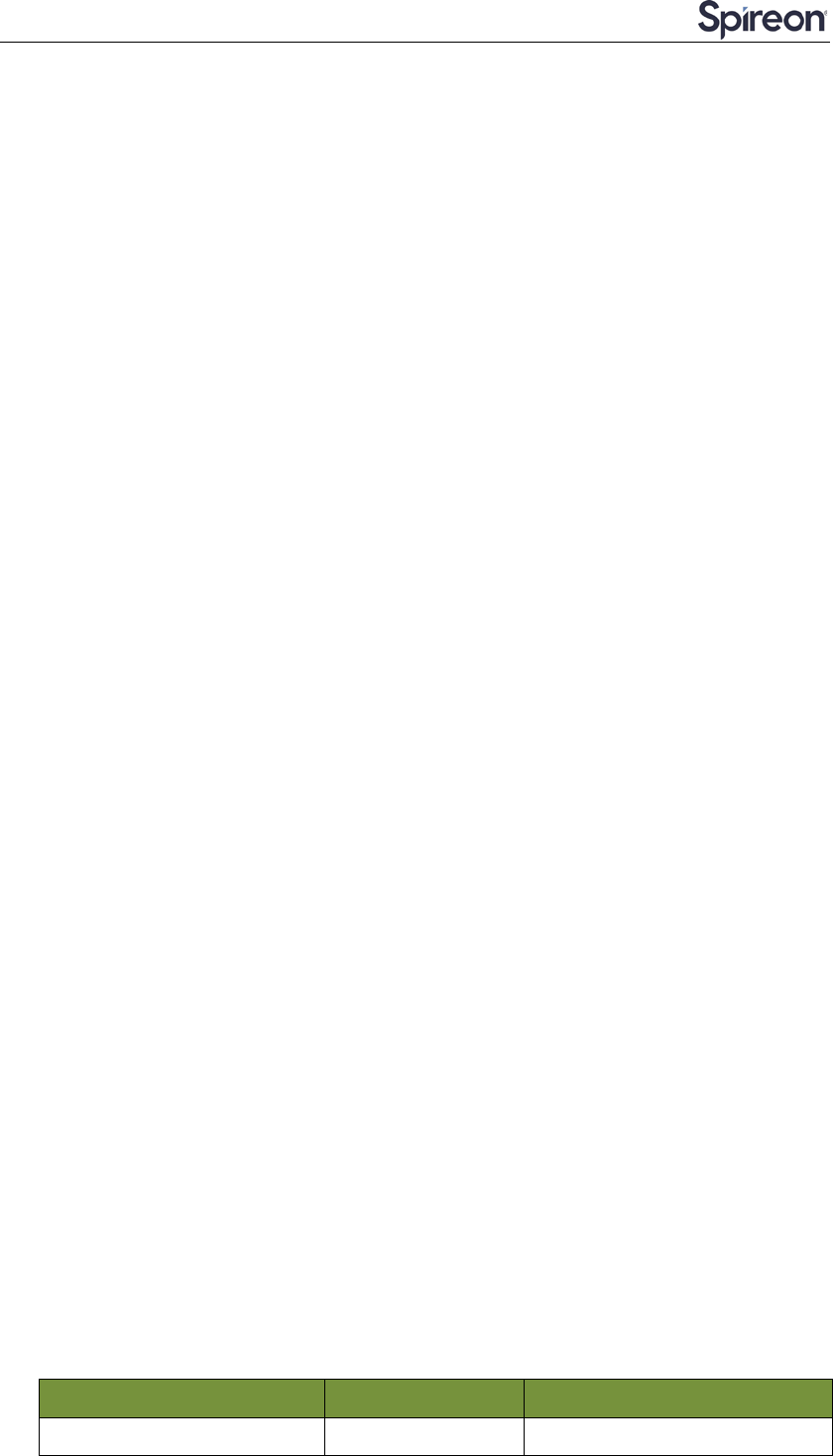
© 2017 Spireon, Inc.7 / 22
Accelerometer
The accelerometer is used for motion start detection to wake the unit up from a sleep mode
and driving behavior monitoring.
UART
A UART port is provided for AT command and data interaction. The UART can also serve to
attach other accessories, such as cargo sensor.
1-Wire
A 1-Wire interface is supported to attach external sensors, such as temperature sensor, etc.
Relay Driver
A 500mA sink capable output pin is provided. This pin is meant to drive a relay coil indented
to interrupt the starter solenoid relay for the ignition circuit to a car.
Ignition Monitor
One of the GPIO’s can be wired to vehicle ignition to monitor and trigger event upon ignition
start and stop.
Power Out
The JG-H provides a power out option at 3.3V and up to 300mA to enable powering up
external devices. The power out is turned off by default and is controlled by software.
Tamper
Tamper detection pin is available on the external connector. The Tamper pin can trigger an
alert when disconnected from ground.
Solar Panel
The JG-H includes an integrated solar panel that constantly charges the battery when exposed
to light.
Power Monitor
The internal power monitor circuitry allows to measure the voltage on all possible power
sources: Main, Auxiliary, Battery, Solar.
Timers
Timers resident on the baseband chip generate periodic interrupts for power down, wakeup,
report generation and other timer related functions.
2.2 Basic RF Performance
Items Requirements
Remark
TRP free space >= 20 dBm TRP free space
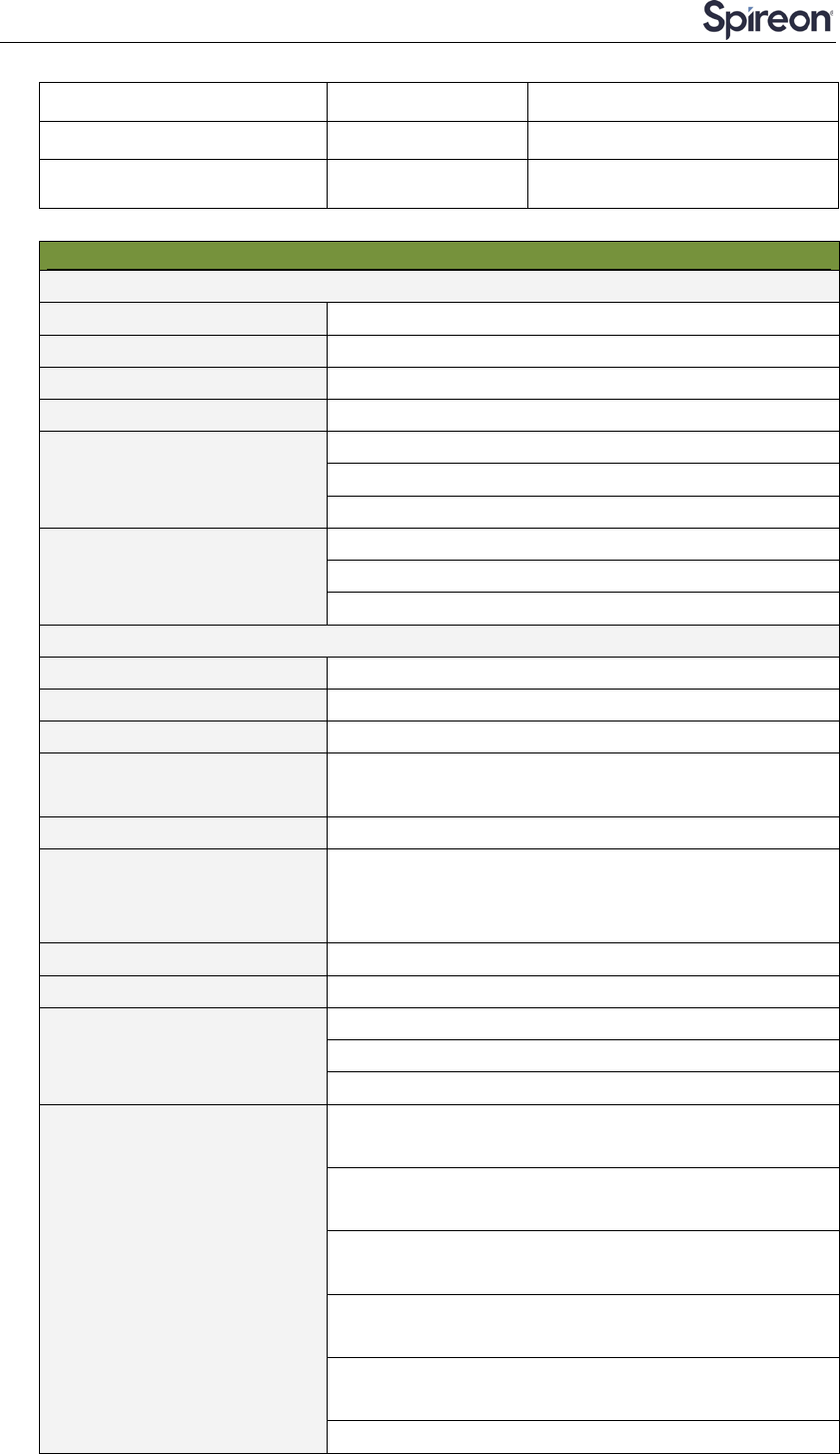
© 2017 Spireon, Inc.8 / 22
TIS free space <= -104dBm TIS free space
Antenna loss <= -3dB TRP-TX Power Conducted
Antenna Loss <= -3dB
RX receive sensitivity conducted
– TIS
Board RF Specification
Cellular Band RX
2G Frequency range 935MHz~960MHz
Sensitivity -108dBm (FER≤0.5%)
Dynamic range
-25
~
-108dBm (FER≤0.5%)
Single tone Desensitization
-102.4dBm(FER≤1%,-30dBm@±900KHz)
Intermediation Spurious
Response Attenuation
-102.4dBm(FER≤1%,-43dBm@±900 KHz/±1800KHz)
-91.4dBm(FER≤1%,-32dBm @±900 KHz/±1800KHz)
-80.4dBm(FER≤1%,-21dBm @±900 KHz/±1800KHz)
Conducted Spurious
Emission
<-76dBm/1MHz(RX band)
<-61dBm/1MHz(TX band)
<-47dBm/30KHz(other frequency)
Cellular Band TX
2G Frequency range 890MHz~915MHz
Maximum Frequency error
±200KHz
Maximum output power
21
~
32dBm
Minimum controlled output
power
<-50dBm
Standby output power <-61dBm
Code domain power
The code domain power in each inactive code channel
shall be 23 dB or more below the total output power
measured on both the I and Q data channel combined.
Time reference
±1.0uS
Waveform quality >0.944
Range of open loop output
power
(test1:-25dBm/1.23MHz)-47.7±9.5dBm
(test2:-60dBm/1.23MHz)-7.7±9.5dBm
(test3:-93.5dBm/1.23MHz)20.3±9.5dBm
Conducted spurious emission
-42dBc/30Khzor-54dBm/1.23MHz
(|Δf|:1.25MHz~1.98MHz)
-50dBc/30Khzor-54dBm/1.23MHz
(|Δf|: 1.98MHz~4.00MHz)
<-36dBm/1kHz
(|Δf| > 4MHz, 9KHz < f < 150KHz,)
<-36dBm/10kHz
(|Δf| > 4MHz, 150kHz<f<30MHz,)
<-36dBm/100kHz
(|Δf| > 4MHz, 30MHz<f<1GHz)
<-30dBm/1MHz
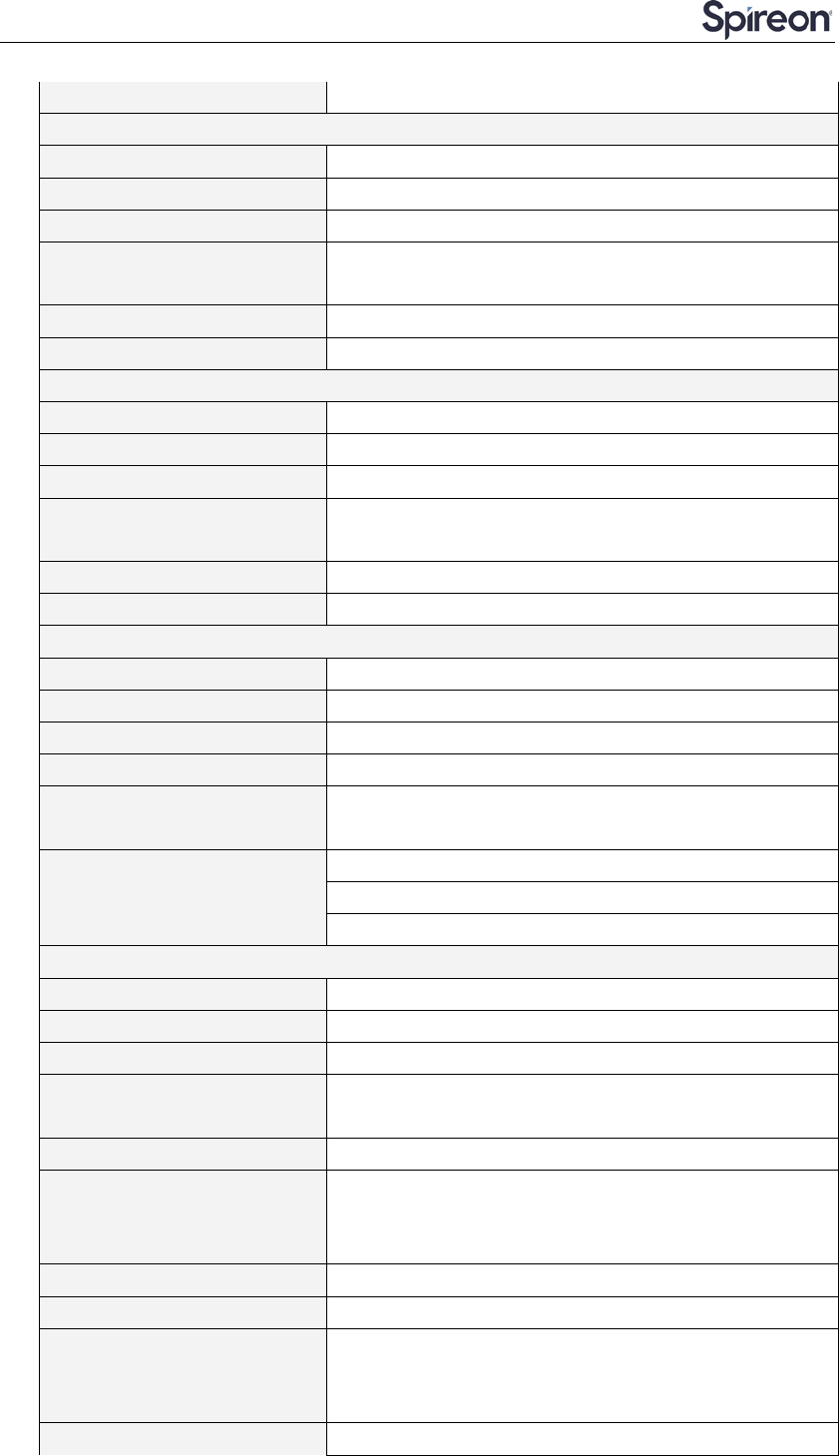
© 2017 Spireon, Inc.9 / 22
(|Δf| > 4MHz, 1GHz<f<12.75GHz)
WCDMA Band1 RX
3G Frequency range
2110MHz~2170MHz
Maximum Frequency error
±200KHz
Maximum output power 21~24dBm
Minimum controlled output
power
<-50dBm
Standby output power
<-61dBm
Error Vector Magnitude
<17.5%
WCDMA Band1 TX
3G Frequency range 1920MHz~1980MHz
Maximum Frequency error ±200KHz
Maximum output power 21~24dBm
Minimum controlled output
power
<-50dBm
Standby output power <-61dBm
Error Vector Magnitude <17.5%
DCS Band RX
Frequency range 1805MHz ~ 1880MHz
Sensitivity -108dBm (FER≤0.5%)
Dynamic range -25 ~ -108dBm (FER≤0.5%)
Single tone Desensitization -102.4dBm(FER≤1%,-40dBm@±1250KHz)
Intermediation Spurious
Response Attenuation -102.4dBm(FER≤1%,-43dBm@±1250KHz/±2050KHz)
Conducted Spurious
Emission
<-76dBm/1MHz(RX band)
<-61dBm/1MHz( TX band)
<-47dBm/30KHz(other frequency)
PCS Band TX
Frequency range
1710MHz ~ 1785MHz
Maximum Frequency error ±200KHz
Maximum output power 23 ~ 30dBm
Minimum controlled output
power
<-50dBm
Standby output power
<-61dBm
Code domain power
The code domain power in each inactive code channel
shall be 23 dB or more
below the total output power
measured on both I and Q data channel combined.
Time reference ±1.0uS
Waveform quality >0.944
Range of open loop output
power
(test1: -25dBm/1.23MHz) -50.7±9.5dBm
Conducted spurious emission
(test2: -60dBm/1.23MHz) -10.7±9.5dBm

© 2017 Spireon, Inc.10 / 22
(test3: -91.3dBm/1.23MHz) 20.3±9.5dBm
-42dBc/30Khzor-54dBm/1.23MHz
(|Δf|:885KHz~1.98MHz)
-54dBc/30Khzor-54dBm/1.23MHz (|Δf|:
1.98MHz~4.00MHz)
<-36dBm/1kHz (|Δf| > 4MHz, 9KHz < f < 150KHz)
<-36dBm/10kHz (|Δf| > 4MHz, 150kHz<f<30MHz)
<-36dBm/100kHz (|Δf| > 4MHz, 30MHz<f<1GHz)
<-30dBm/1MHz (|Δf| > 4MHz, 1GHz<f<12.75GHz)
GPS
Frequency Support
L1-band (1.57542GHz)
Channels: 210 PRN, 66 Search, 22 Simultaneous
tracking
Sensitivity
Sensitivity (UHIS):
Tracking: -156dBm
Reacquisition: -153dBm
Acquisition: -144dBm
Tracking Time Requirement
Acquisition time:
Hot: <2s
Warm: <15s
Cold: <60s
Reacquisition: 2s - 10s Depends on signal level
2.3 Certification and Safety
Items
Requirement
Drop Design 1.2meter 6 direction standard drop test
Temperature Range -20 to 65C Operation
-40 to +85° C Storage
Humidity: 20% to 90% Operation
10% to 95% Storage
Altitude:
-500 to +18,000m
Vehicle ISO Test ISO7637-2-2004; ISO7637-3-2007; ISO10605-2008;
ISO16750-2-2010
FCC Certification FCC 47 CFR Part 15 ,Part 2,Part 22,Part 24
Others Operator Requirement Industry Canada/ AT&T (optional)
ESD Requirement
10KV non-Conductive
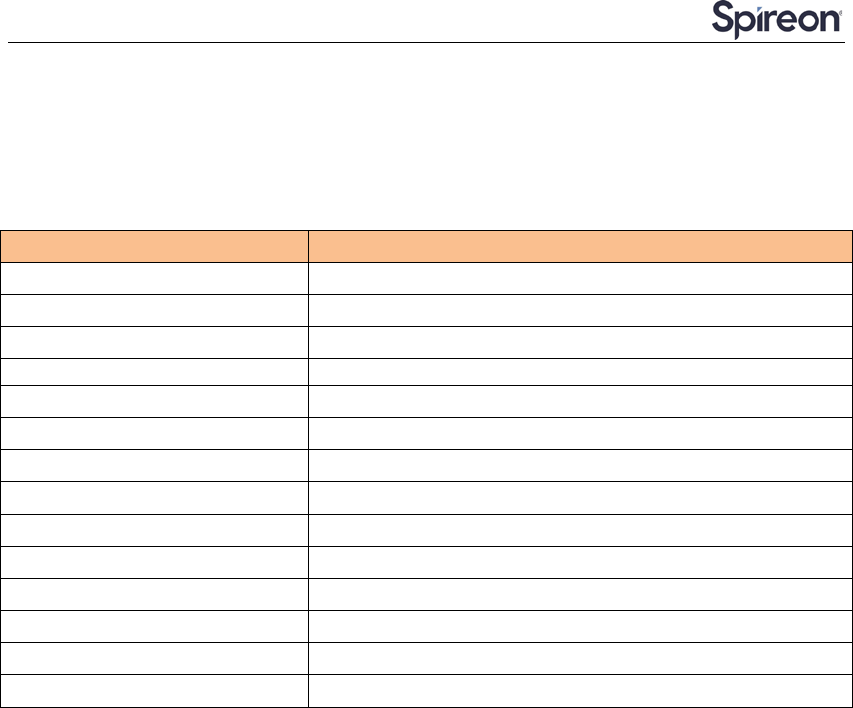
© 2017 Spireon, Inc.11 / 22
3 Software Features
3.1 Basic Software
Items
Requirement
Network Interface GSM 900/1800MHz/WCDMA(Band1); GPS
GPRS Data Supported
IP Stack Ipv4/IPV6
Upgrade Method
Remote update/ PC tool
Remote Update
Supported
Power Modes
Supported
AT Command
Supported
Report
Supported
Driver
GPIO
,
LED
,
GPS
,
UART
,
3.3V out, Accelerometer
GPIOs
Interrupt for Cargo Sensor, Ignition Status, Tamper
LEDs GPS Status, WCDMA Status, Battery Charging
Watch Dog Supported
Reset Soft reset, hard reset, GPS reset, RF reset
Startup Banner
Supported
3.2 Remote Update
The JG-Hsupports OTA field upgrades of the JG-Hresident application. An over the air TFTP
(Trivial File Transfer Protocol) connection is made over a UDP/IP connection. A replacement
file is then transferred from a server to the JG-Hand that file replaces the previous application
image.
3.3 Power Modes
The JG-H device supports several power modes that are set by AT commands. In full power
mode the GPS is active and the cellular subsystem will maintain a persistent cellular
connection whenever service is available. IP connection is maintained according to the
configuration of the device.
The device can be put in a sleep mode whenever it runs on an internal battery, if the external
battery is low or if the device is not moving. In low power mode the GPS is not running and
the LED’s are off. The device would return to full power whenever an event occurs that
triggers a report. Those events include:
• GPIO change
• Battery threshold
• Heartbeat
• Power-up
• Accelerometer
• Tamper
Any hardware or software reset will return the device to full power mode.

© 2017 Spireon, Inc.12 / 22
3.4 AT Command
JG-Hcommands are AT extensions specific to JG-H devices. They are closely based on
commands that are as similar as possible to other industry common devices. Native AT
commands supported by the baseband modem are also available via the serial interface.
Command Summary
The following commands are specific to the JG-H. They are organized by categories.
Event Setting Commands
The following set of commands enables/disables reporting of the various events and state
transitions that take place in the system. The event setting commands typically include
trigger(s) that indicate what event or state transition would cause an event report to be sent.
Often state transitions also qualified with “debounce” time to prevent various flickers and
intermittent state transitions. Examples are: (1) state change of an input pin; (2) crossing a
geo-fence line for a brief period of time and then crossing it back.
As a general rule every event and state transition has its own unique event ID that is reflected
in the report triggered by the said event. Refer to Table 2 – Events for the complete list of
event ID’s. Those default event ID’s can be changed by the user to accommodate specific
server implementations, by explicitly specifying what they are in the respective commands.
As an example, all trip related events can be mapped to the same event ID, so there is no need
to parse the specific event trigger. Following is a list of event setting commands:
1. AT+XBTLE Battery Low Event
2. AT+XBUBE Backup Battery Events
3. AT+XCCLE Cellular Connection Lost/Lock Events
4. AT+XDRI Drive Report Intervals
5. AT+XDTS Drive Trip Start/Stop
6. AT+XGFE Geo-Fence Enable
7. AT+XGME G-sensor Motion Events
8. AT+XGPL GPS Lost/Lock
9. AT+XHB Heart Beat
10. AT+XIA Idle Alert
11. AT+XIGN Ignition
12. AT+XIOE I/O Event
13. AT+XIPC IP Changed
14. AT+XPUP Power Up
15. AT+XPWE Power Events

© 2017 Spireon, Inc.13 / 22
16. AT+XRLYE Relay Event
17. AT+XSLPE Sleep Events
18. AT+XRSTE Reset Event
19. AT+XSPD Speeding
20. AT+XTA Tow Alert
21. AT+XTMPRE Tamper Event
22. AT+XVTOE Virtual Trip Odometer Event
Action Commands
Action commands instigate an immediate action. They cannot be included in configuration
files. Following is a list of action commands:
23. AT+XBUBX Back-Up Battery eXit
24. AT+XCC Clear Counters
25. AT+XCSRN Cargo Sensor Report Now
26. AT+XFDR Factory DefaultsRestore
27. AT+XFDU Factory DefaultsUpdate
28. AT+XMRN Maintenance Report Now
29. AT+XRN Report Now
30. AT+XRNE Report Now Echo
31. AT+XRPQD Report Queue Dump
32. AT+XRST Reset - soft/hard
33. AT+XVEGH Virtual Engine-Hours
34. AT+XVO Virtual Odometer
35. AT+XVTO Virtual Trip Odometer
36. AT+XUMA Unauthorized Motion Alert
File Update Commands
37. AT+XUAPP Update Application file OTA
38. AT+XUFW Update Firmware file OTA
39. AT+XUIO Update IO controller file OTA (Battery powered devices only)
40. AT+XUUC Update User Configuration file OTA

© 2017 Spireon, Inc.14 / 22
Periodic Action Commands (with Events)
Periodic Action commands trigger time based periodic action, such as reset, data session
renewal, etc. Some actions can trigger an event report to indicate the respective action took
place. Following is a list of event setting commands:
41. AT+XKA Keep Alive
42. AT+XPST Packet Session Timeout
43. AT+XRSTP Reset Periodically
Configuration Commands
Configuration commands control various parameter settings of the device. For convenience
they are grouped into topical settings. Following is a list of configuration commands:
Communication related settings
44. AT+XAPN Set APN (GSM devices only)
45. AT+XCSW Cellular Session Watchdog
46. AT+XIP Set target server IP address and port number
47. AT+XLPORT Set Local IP port number
48. AT+XMIP Set Maintenance server IP address and port number
49. AT+XPRP PxP Renewal Policy
50. AT+XSMSD SMS Destination
51. AT+XSMSS SMS Source
52. AT+XSPIP Set Serial Port (A-UART) IP address and port number
53. AT+XUIP Set Update server IP address and port number
Protocol related settings
54. AT+XCRA Command Response Appendix
55. AT+XITM Item Mask
56. AT+XRPA Report Acknowledge
57. AT+XRPF Report Format
58. AT+XRPM Report Mask
59. AT+XRPQ Report Queue length
60. AT+XRPSF Report Start Frame
Drive Trip related settings
61. AT+XDDI Drive Distance Interval
62. AT+XDHC Drive Heading Change

© 2017 Spireon, Inc.15 / 22
63. AT+XDMED Drive Motion End Distance
64. AT+XDMES Drive Motion End Speed
65. AT+XDMSD Drive Motion start Distance
66. AT+XDMSS Drive Motion Start Speed
67. AT+XDMST Drive Motion Start Trigger
68. AT+XDMET Drive Motion End Trigger
69. AT+XDTT Drive Trip Trigger
70. AT+XUMSD Unauthorized Motion start Distance
71. AT+XUMSS Unauthorized Motion Start Speed
72. AT+XUMST Unauthorized Motion Start Trigger
Peripheral related settings
73. AT+XBTL Battery Low
74. AT+XBUB Back-Up Battery
75. AT+EGHM Engine Hours Mode
76. AT+XGMTH G-sensor Motion Threshold
77. AT+XGPLP GPS Lock Parameters
78. AT+XGPLT GPS Lock Timeout
79. AT+XIGM Ignition Mode
80. AT+XIGV Ignition Voltage
81. AT+XIOD I/ODirection
82. AT+XIOW I/O Write
83. AT+XLEDO LED’s Off
84. AT+XODM Odometer Mode
85. AT+XOWM One-Wire Mode
86. AT+XPWET Power Event Threshold
87. AT+XPWSMM Power State-Mode Mobile
88. AT+XPWSMS Power State-Mode Stationary
89. AT+XPWST Power State Threshold
90. AT+XPWSRC Power Source Configuration (Puma, Jaguar only)
91. AT+XRLY Set Relay
92. AT+XRLYO Relay Override Policy

© 2017 Spireon, Inc.16 / 22
93. AT+XSPC Serial Port Configuration
94. AT+XTMPRM Tamper Mode
Maintenance report settings
95. AT+XMHB Maintenance Report Heart Beat
96. AT+XMITM Maintenance Item Mask
97. AT+XMRC Maintenance Report Clone
98. AT+XMRPM Maintenance Report Mask
Miscellaneous settings
99. AT+XCIN Configuration Id Number
100. AT+XCIV Configuration Id Version
101. AT+XEVIT Event Items
102. AT+XEVITD Event Item Default
103. AT+XGF Geo-Fence
104. AT+XGFH Geo-Fence Here
105. AT+XLW Listening Window
106. AT+XSLCK SIM Lock
Information Commands
Information commands simply output various data regarding the current status of the device.
They are mostly useful for troubleshooting. Following is a list of information commands:
107. AT+XGFR Geo-Fence Read
108. AT+XIOR I/O Read
Configuration reading commands
109. AT+XCFD Configuration file – Default
110. AT+XCFU Configuration file – User
Information commands
111. AT+XINCEL Info: Cellular
112. AT+XINDAT Info: Data
113. AT+XINEVT Info: Events
114. AT+XINGPS Info: GPS
115. AT+XINNET Info: Network
116. AT+XINPWR Info: Power

© 2017 Spireon, Inc.17 / 22
117. AT+XINVER Info: Versions
118. AT+XEVITR Event-Item Read
Report
The JG-H captures data and forms a report record with that data. A report is a data structure
containing all of the sensory and other typically useful data on the device. Reports are
generated in response to specified events, such as periodic timeout, speed threshold,
geo-fence crossing, etc., or in response to a Report Now command (AT+XRN).
Report Queuing
If a report trigger occurs while UDP connection is unavailable, it will be queued until
connection becomes available and transmitted at such time. The only way report(s) can be lost
is if too many reports are queued and the report-queue is overflowing. In such case the earliest
report(s) will be discarded. The size of the queue can be configured via the Report Queue
(AT+XRPQ) command.
Ack’ed Mode
UDP is not a 100% reliable connection and occasional reports or command/responses may be
lost. Since all commands have responses, the server can repeat any command to which there
is no response. In order to assure reliable reception of reports, the device can be configured
either in Normal or Ack’ed mode to send the reports. In the Normal mode the reports are
simply sent “as is” with no acknowledgment from the server. In the Ack’ed mode every
report sent is expected to be acknowledged by the server by sending back an ACK message
back. If acknowledgement is not received within the specified timeout, the report is re-sent. If
the report is not acknowledged after the specified number of attempts, it is queued. If
acknowledgement is received after the report is queued (i.e. past timeout of the last attempt),
it is ignored.
Report is not considered “complete” until its acknowledgement is received. Thus, if report X
is sent and report X+1 is triggered while waiting for acknowledgement of X, report X+1 will
be queued until such acknowledgement is received and only then sent. The JG-H will attempt
to re-send queued report(s) every time a new report is triggered. If there is more than one
report queued, the reports will attempt to be sent in the order of triggering and only once the
report is acknowledged, the next report is attempted. This assures that reports are sent and
received in order.
Ack’ed mode assures that all reports are received, but adds overhead in time and data. Report
that is not acknowledged is sent again and eventually will be queued and sent again. The
number and frequency of re-tries is configurable via the Report Acknowledgement command
(AT+XRPA).
Event Report Format
Reports are encoded as binary hex.

© 2017 Spireon, Inc.18 / 22
3.5 Reset
There are a number of resets available on the device. Soft reset only restarts the baseband on
the device. Hard reset is caused by resetting the whole baseband module via a reset pin. There
is also an option to reset the cellular and GPS sub-systemsindividially.
3.5.1 Context Preservation
When a self-initiated reset is performed due to Network Watchdog or by the Reset command
(modes 0,1), the context of the system is being preserved and is restored after the reset. The
context includes all the periodic timers, the report queue, the odometer, etc. This allows to
reset the unit as a troubleshooting or preventive measure without losing reports that are
already in the queue or are pending on running timers. Note that the reset process may cause
1-2min of inaccuracy in the timers and should not be considered as very precise.
3.6 Startup Banner
After a reset a startup banner is printed through the UART only.
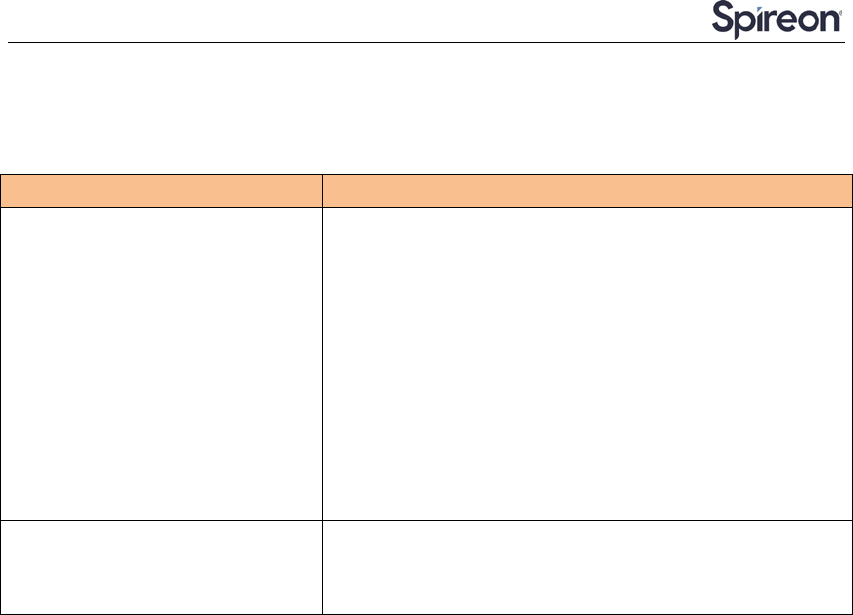
© 2017 Spireon, Inc.19 / 22
Test Method
3.7 Hardware
Test Item Description
Baseband Function Test • Power Input Test
• Power Consumption and Current Test
• Heat Dissipation Test
• UART Stability Test
• GPIO Level Test
• LED Stability Test
• Drop Down Test
• ESD Test
• High/Low Temperature Test
• Humidity Test
RF Test • RF Performance Test
• GPS Performance Test
• Antenna Performance Test
3.8 Software Test
Test Environment Construct
Message Test environment
1. USB dongle and PC as message server
2. Send message to JG-H
UDP Test environment
1. Connect dongle to PC and create dialup as ip server
2. JG-H create IP connection to server
UART Test environment
1. Connect JG-H to pc with com serial cable
2. Open Terminal tool and send at command
3. Response can be shown at terminal window
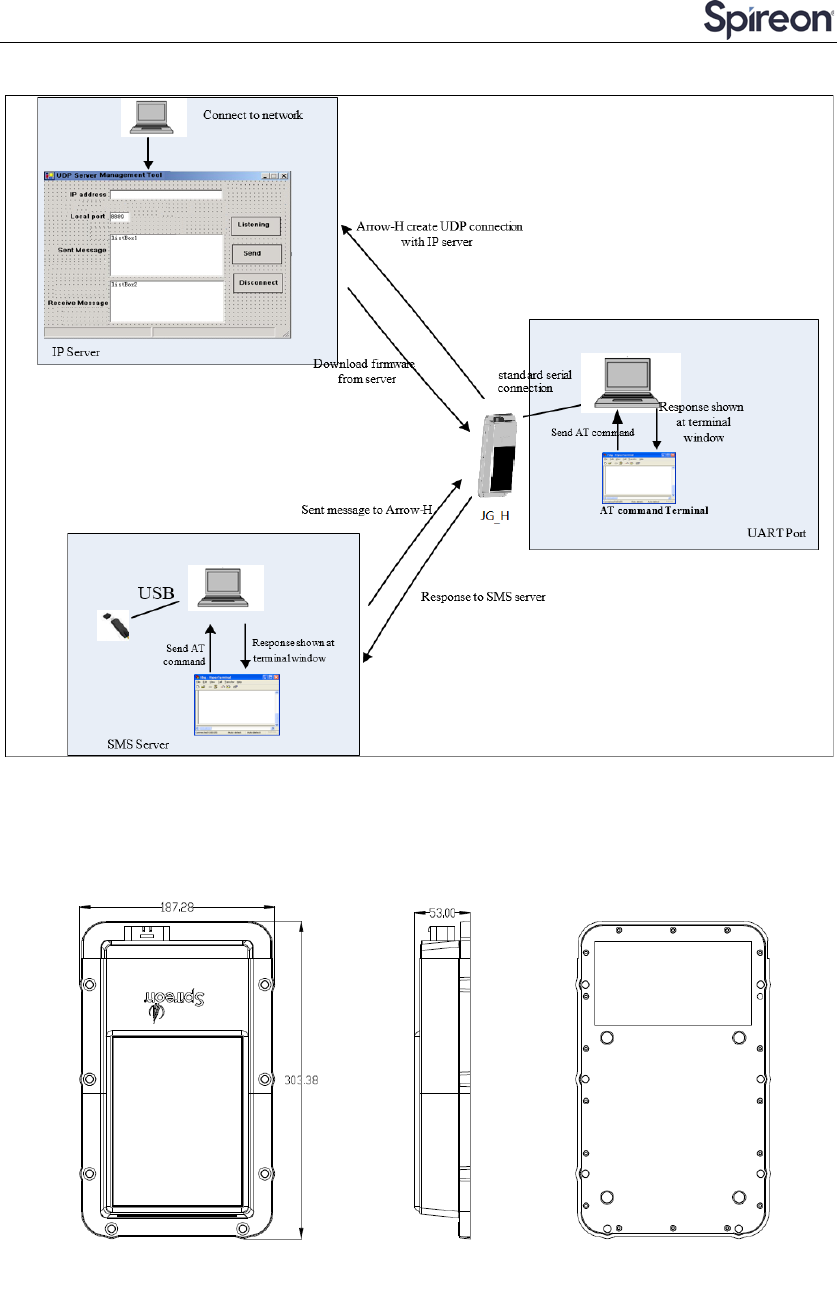
© 2017 Spireon, Inc.20 / 22
Mechanical Structure(mm)

© 2017 Spireon, Inc.21 / 22
FCC Statement
RF Exposure Warning Statements:
The antenna(s) used for this transmitter must be installed to provide a separation distance of at
least 20 cm from all persons during the normal operations.
This equipment has been tested and found to comply with the limits for a Class B digital device,
pursuant to Part 15 of the FCC Rules. These limits are designed to provide reasonable protection
against harmful interference in a residential installation. This equipment generates uses and can
radiate radio frequency energy and, if not installed and used in accordance with the instructions,
may cause harmful interference to radio communications. However, there is no guarantee that
interference will not occur in a particular installation. If this equipment does cause harmful
interference to radio or television reception, which can be determined by turning the equipment
off and on, the user is encouraged to try to correct the interference by one or more of the following
measures:
-- Reorient or relocate the receiving antenna.
-- Increase the separation between the equipment and receiver.
-- Connect the equipment into an outlet on a circuit different from that to which the receiver is
connected.
-- Consult the dealer or an experienced radio/TV technician for help.
This device complies with part 15 of the FCC Rules. Operation is subject to the following two
conditions:
(1) This device may not cause harmful interference, and (2) this device must accept any
interference received, including interference that may cause undesired operation.
Changes or modifications not expressly approved by the party responsible for compliance could
void the user's authority to operate the equipment.
IC STATEMENT
This device complies with Industry Canada licence-exempt RSS standard(s). Operation is subject
to the following two conditions: (1) this device may not cause interference, and (2) this device
must accept any interference, including interference that may cause undesired operation of the
device.
Le présentappareilestconforme aux CNR d'Industrie Canada applicables aux appareils radio
exempts de licence. L'exploitationestautorisée aux deux conditions suivantes : (1) l'appareil ne doit
pas produire de brouillage, et (2) l'utilisateur de l'appareildoit accepter tout
brouillageradioélectriquesubi, mêmesi le brouillageest susceptible d'encompromettre le
fonctionnement.
In order to avoid the possibility of exceeding the IC radio frequency exposure limits, human

© 2017 Spireon, Inc.22 / 22
proximity to the antenna shall not be less than 20cm (8 inches) during normal operation.
Afind'éviter la possibilité de dépasser les limitesd'exposition aux fréquences radio de la IC
CNR102, la proximitéhumaine à l'antenne ne doit pas êtreinférieure à 20 cm (8 pouces) pendant
le fonctionnement normal.